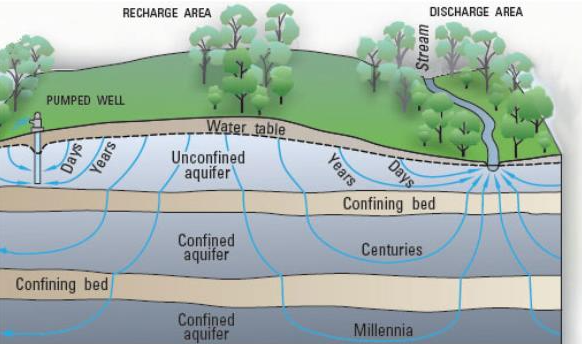CRAWFORD COUNTY, OH (CRAWFORD COUNTY NOW)—Crawford County Public Health would like to remind residents that many households in our community rely on private water systems, such as wells, to provide safe drinking water. Unlike homes connected to public water supplies, private wells draw water directly from an underground source known as an aquifer.
How an Aquifer Works An aquifer is a natural underground formation made of layers of sand, gravel, or porous rock that can hold and move water. Rain and melted snow seep through the soil and collect in these underground layers, creating a reservoir of groundwater. When a well is drilled into the aquifer, a pump brings the water up to the surface for household use.
Recharge does not happen overnight. On average, it can take months to years for water from the surface to filter through the soil and reach the aquifer. In some cases, depending on depth and rock layers, it can take decades or even centuries for surface water to move into deeper aquifers. This natural filtration process helps clean the water, but also means that once an aquifer is contaminated, it can take a long time to recover.
“Private wells are a vital source of drinking water for many families,” said Kate Siefert, Crawford County Health Commissioner. “But unlike public water systems, which are regularly monitored and tested, private water systems are the responsibility of the homeowner. Understanding how aquifers work helps families see why protecting the land around their wells is so important.”

The health department emphasizes the following key points:
· Well Maintenance: Routine inspection and proper construction help prevent contaminants from entering the water supply.
· Water Testing: Well water should be tested at least once a year for bacteria, nitrates, and other potential contaminants.
· Protecting the Aquifer: Everyday actions such as limiting fertilizer use, properly disposing of chemicals, and maintaining septic systems help protect the underground water source.
By understanding how private wells and aquifers work together—and how long it takes for water to move underground—residents can take proactive steps to safeguard their drinking water.
For more information on private water system safety, recommended testing, or local water resources, please contact the Environmental Health Division of Crawford County Public Health at (419) 562-5871 or visit Residential Water section on our website: crawfordhealth.org/residential-water/ .


